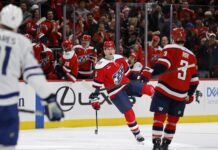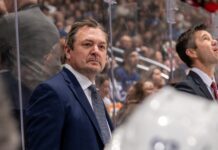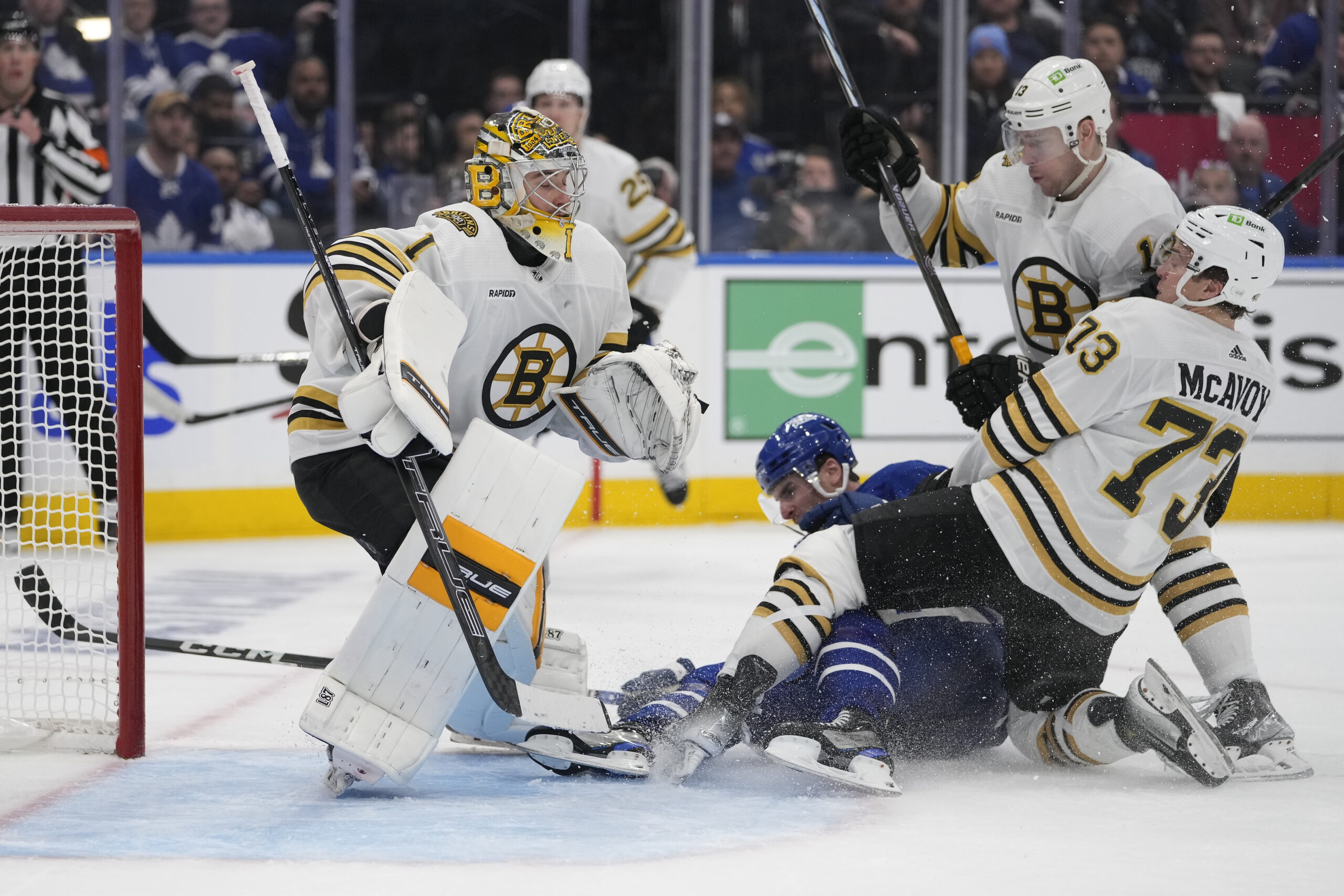Throughout the season and playoffs, we generally write post-games in a “Game in 10” format, breaking down the game into 10 digestible points that highlight goals, matchups, systems, and more.
After Game 4, I don’t believe that format is a proper way to discuss what happened. This game was unacceptable, and the overall outcome should have ramifications across the organization unless the Leafs manage to come back and win this series.
I can appreciate that the Leafs‘ best player, Auston Matthews, is playing through some sort of sickness and that their second-best player, William Nylander, just returned from a mysterious absence (thought to be migraines). Obviously, these unfortunate circumstances will hurt their chances of success no matter how we slice it. But less-than-ideal circumstances require adjustments, extra efforts, and a heightened attention to detail. The Leafs simply refuse to recognize and practice those things.
On the first shift of the game, the Leafs won the faceoff, and Morgan Rielly gained center ice, then dumped the puck by rimming it to the far corner. Hampus Lindholm went back to retrieve the puck, and Brad Marchand — off the faceoff — ran some interference on Max Domi that you couldn’t really see on the TV broadcast. Instead of fighting through it — potentially even attempting to draw an interference penalty as a result — Domi accepted the interference, slowed down, and was nowhere near Lindholm as he retrieved the puck.
Lindholm had the time to calmly control the puck and flip it out, and instead of at least trying to finish his hit, Domi actively stopped. The puck went all the way down the ice, where Morgan Rielly was slow to skate to it, allowing Morgan Geekie the time to catch up, pressure him to rim it to the far side, and lay a hit. The puck went up the far wall, where Charlie Coyle was waiting for it. The Bruins created some zone time and a point shot that they just missed deflecting (not for lack of being open) before the Leafs eventually won the puck back, got to center ice, and were able to dump and change.
Really, what about this sequence involved a particularly high level of skill from the Bruins? One team forechecked hard and skated back hard to the puck to break out of their zone. The other team didn’t. It’s Game 4 of the series; the Leafs were at home, they’re losing the series, and the first shift of the game was completely flat.
A few shifts afterward, the fourth line went out, and instead of getting the puck in deep strategically and forechecking hard, Jake McCabe tried to hit Nick Robertson with a pass in stride through the Bruins’ neutral-zone trap with Jesper Boqvist right in front of him. The pass exploded off his stick and deflected into the zone. Charlie McAvoy retrieved it and made a simple reverse that was so open that Simon Benoit felt compelled to skate all the way to the corner to apply some level of pressure (McAvoy, the Bruins’ best defenseman, did not take a hit in any capacity despite retrieving the puck against the Leafs’ fourth line). Boqvist chipped it by him to the winger John Beecher, who then chipped it up to Pat Maroon, who went on a 2v1 that Jake McCabe had to dive to break up.
Again, what was the skill here? One team played simple, honest hockey, while the other played a brand of hockey that is not successful in the playoffs (not winning the neutral zone, not forechecking properly, etc.) in the best of circumstances, let alone when two of its best players were in questionable health at best.
A few shifts afterward, the Leafs received a gift as the Bruins took a too-many-men penalty. The Bruins’ penalty kill won the faceoff, headed down the ice, and controlled play for over 30 seconds against the Leafs’ top unit, outworking them for the puck multiple times in the sequence. The power play created one look for Tyler Bertuzzi in the slot, but it was otherwise listless.
It’s an important segment to highlight, given the post-game comments from Sheldon Keefe: “Nothing is wrong with our effort level tonight.” Watching the Bruins win a shorthanded faceoff and Brad Marchand skate the puck from his own hashmark all the way down the ice and across the Leafs’ blue line completely untouched — while the Leafs have the extra player on the ice — is an issue that falls in the effort category. There is no skill involved in working hard to get the puck back. You either do it or you don’t, and the Leafs aren’t. Their power play is 1/14 in the series now, and we will hear players talk about this all the time (Justin Williams has said it multiple times on the Sportsnet panel): You can’t let the penalty-killing unit outwork your power play.
That includes a 4v3 power play later in the first period, where Charlie Coyle had as many shot attempts as the Leafs did. I don’t sit here and question whether the team wants to win (I think that’s often where the line is crossed by fans), but some of this is a lack of effort. They are getting outworked in key areas of the game by the Bruins, who are playing harder and smarter.
The Bruins were rewarded with the first goal of the game. It was the result of another very simple forecheck and a 2v2 battle that the Bruins poked up the wall before their defenseman pinched down and pressured. Instead of Reaves chipping it off the wall and out (or, at worst, jamming it on the wall), he tried to go up the middle. It was deflected and landed right on the tape of JVR, who was all alone and buried with a nice move. That was better than any single scoring chance the Leafs created in the first two periods, and all it stemmed from was the Bruins forechecking and winning a few battles.
Sitting in the arena with a corner view of the whole ice, it was clear as day that this Leafs team simply refuses to go through the neutral zone properly. The Bruins are packing five players between the two blue lines (and sometimes between their blue line and center) and daring the Leafs to try to get through it. The Leafs keep banging their heads against the wall. Some of their only success came when William Nylander swung back to the defense to grab the puck and try to do it himself. Otherwise, the Leafs’ defense is attempting to rip passes to wingers who are covered and are, at best, deflecting the puck in deep. This can be fine if they time it with their off-puck forwards gaining speed and flying into the zone to forecheck, but the Leafs are not even coming close to that.
The Leafs put 16 shots on net through two periods in this game. The Bruins know that all they need to do is sit back and wait for the Leafs to make mistakes at five-on-five and that they will win the special teams battle.
And that was Boston’s next goal. We can argue about the penalty call (I thought it was soft, to be honest), but the Leafs have allowed at least one power-play goal in every game this series. It’s unrealistic to expect to win this way against quality opponents. I’ve watched the goal about 15 times already, and the penalty-killing unit committed a calamity of errors leading to about as easy a goal as you can possibly score. The Leafs’ PKers looked like strangers out there as each player was pulled way out of position at some point in the sequence leading up to the goal.
Down 2-0, the Leafs mounted no real push offensively. There was clear frustration on the bench and within the overall arena. The Bruins are playing smarter and not giving the Leafs anything easy. At the end of the period, they were rewarded with a bit of a lucky bounce. The puck deflected off Jake McCabe’s skate and bounced to no-man’s land. It’s a really tough play for TJ Brodie, who immediately knew he was caught in a tough spot (the Bruins were attempting to dump the puck in, and he was turning to go get it before it bounced out of his initial reach). The Bruins won the race, got a 2v0, and made no mistake to end the period.
From there, the rest of the game was elementary. Sure, the Leafs created some chances and even scored a goal, but that was not serious hockey across the board. The Bruins took their foot off the pedal, and after Marner scored followed by Nylander’s great scoring chance (which would have made it interesting), they tightened back up.
The most interesting part of the third period was Matthews’s absence (how sick is he? He is clearly off his game) and the decision to pull Ilya Samsonov for Joseph Woll. Did they pull Samsonov to allow him to start preparing for Game 5, or did they say enough is enough; we’re trying something else?
Ultimately, this was a listless game. The Leafs are kidding themselves if they believe anything else. A lot of reality checks and self-reflection are in order. To put up just 25 shots at home in a series they trail 2-1 is not even close to good enough. Jeremy Swayman was essentially untested through two periods. The Bruins are a good defensive team that makes it tough on the opposition. They deserve real credit for it, and nobody is expecting this to be easy. But this is not the 2001 New Jersey Devils.
This was — far and away — the Leafs’ worst game of the series. Speaking personally, I have been to a ton of games over the years and am usually lucky enough to attend at least one playoff game per year since the Leafs made it in 2013. I’ve seen a lot of bad games, including last year’s 7-2 drubbing against Tampa Bay and any number of brutal regular season games over the past decade. The fans were barely even upset at that 7-2 game last spring; there were a number of bad bounces. It didn’t go well, but fans generally recognize what’s what (this is a hockey market). Given the circumstances, Game 4 was the worst I’ve ever been to.
Fans rightfully booed at the end. And make no mistake, they were booing the effort. If there is one thing the Toronto market understands, it’s effort. There is a reason players like Darcy Tucker are celebrated in this market: they laid it on the line, and fans appreciate it. I watched it again on TV the next morning — and the game was bad from that perspective as well — but you can really feel a lackluster effort when you are in the arena watching live. Finding out afterward that the players were visibly upset with each other on the bench in-game was particularly telling. This has been, if anything, an aloof group towards each other over the years of futility.
The Leafs have two days to collect themselves and decide as a group: Are we going to dig in and go down swinging, or will we roll over? This game was an example of them, by and large, rolling over. They created nothing, they had no detail, and they gifted the Bruins two goals.
When teams face adversity in the form of losing their best players, they need to simplify and sacrifice. Instead, it looks like the Leafs are playing the same old style without the same old Matthews and Nylander to carry it. The strategy so far—be it power play or 5v5—appears to be praying to God that they get healthy and return to form. It wasn’t even close to good enough from every single person involved.















![John Gruden after the Leafs prospects’ 4-1 win over Montreal: “[Vyacheslav Peksa] looked really comfortable in the net… We wouldn’t have won without him” John Gruden, head coach of the Toronto Marlies](https://mapleleafshotstove.com/wp-content/uploads/2025/09/gruden-post-game-sep-14-218x150.jpg)



















